#The Agricultural Gazette and Modern Farming
Explore tagged Tumblr posts
Photo
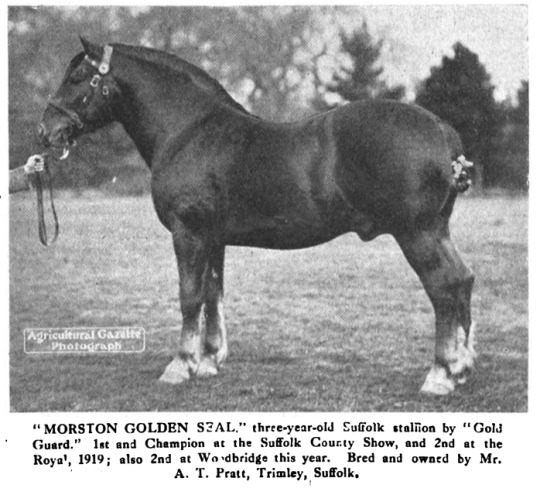
“MORSTON GOLDEN SEAL,” three-year-old Suffolk stallion by “Gold Guard.” 1st and Champion at the Suffolk County Show, and 2nd at the Royal, 1919; also 2nd at Woodbridge this year. Bred and owned by Mr. A. T. Pratt, Trimley, Suffolk.
The Agricultural Gazette and Modern Farming, 18 June 1920.
#Suffolk Punch#rare breed#stallion#draught horse#draft horse#heavy horse#Morston Golden Seal#The Agricultural Gazette and Modern Farming#1920
31 notes
·
View notes
Text

USMCA is a Needed Upgrade from NAFTA. Let’s Get it Passed.
“As Congress reconvenes this week, we’ll have a choice to make — stand by an outdated, 25-year-old North American Free Trade Agreement, or vote to pass the U.S.-Mexico-Canada Agreement, a modern trade agreement that will create thousands of new American jobs,” Sen. Rob Portman (R-OH) writes in The Washington Post.
“Democrats should be leading the charge for its passage, because they have long criticized NAFTA, and because the USMCA addresses the major concerns they have raised with NAFTA,” he adds. “That’s why, if Speaker Nancy Pelosi (D-Calif.) were to bring USMCA to the House floor for a vote, I am confident it would pass.”
Click here to read more.“American farmers and ranchers are the most productive in the world, and consumers in other countries are always wanting American products,” Agriculture Secretary Sonny Perdue writes in the Redwood Falls Gazette. “President Trump has made it his mission to support American agriculture and negotiate better trade deals, so our productive farmers can sell their bounty around the globe . . . Title by title, verse by verse, USMCA improves virtually every component of the old NAFTA.”“Nationwide, more than 2 million American manufacturing workers across 43,000 small and medium-sized businesses depend on access to the Canadian and Mexican markets for economic success,” Rep. Vicky Hartzler (R-MO) writes for Fox News. USMCA “will ultimately deliver an additional $2.2 billion in economic activity within the United States, adding more than 176,000 new jobs to our economy.”“At the end of last month, 14 House Democrats sent a letter to House Speaker Nancy Pelosi, urging her to allow USMCA a vote by the end of the year,” writes Christopher Henney, CEO of the Ohio AgriBusiness Association, in The Columbus Dispatch. "These members represent varied states across the nation, showing how vital this deal is for all Americans."“Move over, Village People. You've got some unexpected competition. A group of U.S growers calling themselves the Farming People have released a parody of the band's disco-era ‘YMCA’ that urges members of a gridlocked Congress including House Speaker Nancy Pelosi to pass the ‘USMCA,’” Julia Limitone writes in Fox Business.
Privacy Policy | Contact the White House | UnsubscribeThe White House · 1600 Pennsylvania Ave NW · Washington, DC 20500 · USA · 202-456-1111
0 notes
Text
Whisky Mac / MacDonald Cocktails

A Great British Drink
The Whisky Mac, short for Whisky MacDonald, is a classic cocktail made with Scotch whisky and green ginger wine. Half 'n' half is customary, but ratios of 3 to 2 or slightly higher have become the modern standard.*
Behind The Bar - How To Make A Whisky Mac At Home
Whisky Mac Drink Recipe:
1 ½ oz blended Scotch whisky
1 oz green ginger wine
Add both ingredients to a glass and stir together without ice. This drink is meant to be a warmer. In fact, depending on the weather, some add a wee bit of boiling water much like a Hot Toddy does.
The MacDonald Cocktail / Whisky Mac History
A Golfer's Favourite
Certainly in chilly weather Scotland anyway, where the Whisky Mac is a staple at golf clubs throughout the country, famous and otherwise. For example, after professional golfers were first allowed use of the clubhouse in 1946,
Participants in the 1950 British Amateur were given free run of The Royal and Ancient Golf Club of St Andrews and were warmed with sincere hospitality and an occasional Whisky Mac-Donald (whisky and ginger wine).†
This makes the Whisky Mac perfect as a British Open golf themed drink.
Charles Blair MacDonald

Armed with this knowledge, you might be inclined to think that the Whiskey Mac's namesake was World Golf Hall of Fame member Charles Blair MacDonald. After all, he was born in 1855 to a Scottish father, went to St. Andrews University, was tutored by Old Tom Morris and competed against Young Tom Morris back in the day.‡
His accomplishments include helping to found the United States Golf Association (USGA), winning the first U.S. Amateur Championship and building the first 18 hole golf course in the United States. Being considered the father of American golf course architecture certainly sounds deserving of a signature drink and (as you'll find out later in this article) that may well be the case. However, another source claims otherwise. So...
Who Is The Whisky Mac Named After?

According to Crabbie's, one of the oldest producers of green ginger wine in Scotland, the Whisky Mac was named after then Brigadier-General Hector MacDonald during the British Raj of the Indian subcontinent (where ‘rāj’ means ‘rule’ in Hindustani).1 Colonel MacDonald was seconded to command the Sirhind district in the Punjab Province in October 1899, which happened to be one of the sources of the sixth cholera pandemic (1899–1923) which spread to Europe via Afghanistan, Persia and southern Russia as well.2
Early treatments for cholera included laudanum and calomel as well as camphor and ginger with the latter two both having had extended use as Bengallee medicines and were very popular as local remedies.3 Legend has it that the General mixed green ginger wine with whisky as a means to help ease symptoms of those suffering from the cholera disease where he was stationed.
MacDonald's Drink Ingredient Inspiration?
Along with its storied medicinal properties, ginger also had a long history as a flavoring in alcoholic drinks. There were countless recipes available at the time for rum & ginger, ginger beer, ginger brandy, ginger gin and of course ginger wine, which dates back to at least 1740 London and the Finsbury Distillery Company's brand called Stone's ginger wine named after grocer Joseph Stone who was an important customer.4
By comparison, ginger and whisky combinations were few and far between. One early example is Robert Burns favourite recipe for a hunting flask (so pre 1796) which included whisky, lemon rinds, bruised ginger, ripe white currants and powdered loaf sugar.5 However, true liquid inspiration for what would become the Whisky MacDonald may have come in 1882 from humor magazine Puck when reader Freddy W. wanted to know a cure for sour apple cholera.6
Take a little Jamaica ginger7 and about half a hand of rye whiskey. Mix the two pretty well and pour them down. Five minutes later take a little Jamaica ginger and about half a hand of rye whiskey. Mix the two pretty well and pour them down. Then you will feel better; but, if you think you are not thoroughly cured, take a little Jamaica ginger and about half a hand - well, that is the way to cure sour apple cholera.
Additional cocktails previously recommended in connection with other cholera treatments at the time included Brandy Mint Juleps, Hot Toddys and Fernet-Branca.8,9
First Published
Its popularity in England prompted inclusion in an American cookbook in 1900 which appears to be its print debut.10 The MacDonald Cocktail which later became the Whisky MacDonald a.k.a Whisky Mac was originally listed simply as being made with one-half ginger wine and one-half Scotch whisky. No specific type of wine or whisky (i.e green or blended for example) was actually specified.
It was noted that although ginger wine was little used in the U.S. at the time, it was readily available at export houses and that Crabbie's was a popular brand on the other side of the pond.
The MacDonald / Whisky Mac Recipe Iterations
Looks like there may have been a long lapse in print visibility, but this style of The MacDonald cocktail (see below for others) reëmerges, becoming the Whisky Mac to differentiate itself as brandy and rum versions are also introduced along the way. Rye whiskey replaces Scotch whisky in a couple drink formulas as well. Here's the original MacDonald recipe's early historical milestones and timeline.
1920s - Fifty-fifty Stone's Ginger Wine and Whisky (voted the drink of drinks by thousands of golfers)11
1930 - ½ Sandy MacDonald whiskey + ½ ginger wine12
1933 - 1 part Scotch malt whisky and 1 part ginger wine.13
1934 - ½ ginger wine + ½ rye whiskey14
1934 - ½ jigger whisky or brandy + ½ jigger ginger wine15
1948 - 1 measure rum + 1 measure ginger cordial16
So, What's The Rub?
Although they cited cold weather was coming,10 - suggesting the book was released later in 1900, even a December print date with a last minute edit only allows just over a year to go from being created in India, to becoming popular in England, to having the word spread to America, etc.2 THAT'S MORE THAN HALFWAY AROUND THE WORLD! Way back when?
Even though there was limited telegraph and telephone service available at the time, this was BEFORE the internet, television and even radio. While it's certainly possible, when you consider all those factors, that time frame seems too short to be realistic.
Alternate theory: Sandy MacDonald was an old Scotch whisky blend from 1840 Edinburgh and Stone's reported an increase in ginger wine sales after the 1832 cholera outbreak.17 Could these two have paired up much earlier than their 1930 listing, say during the third, fourth or fifth pandemic, w/ Sandy Mac being the true namesake and the combo predating 1899?18,19
You'll have to decide. However, as always, when and if further research suggests otherwise, we'll update our findings. Cheers!
Old MacDonald Had A Farm
E-I-E-I-O.
And on his farm he had some drinks,
E-I-E-I-O.
With a MacDonald drink here,
And a MacDonald drink there,
Here a drink, there a drink,
Everywhere a drink-drink.
OK, enough already. As you've probably guessed, there are lots of other Mickey D cocktails. Here's what the genealogical records show in the Mac family tree of mixology so far, oldest to youngest:
Kindred Spirits
Little Mac - lemon juice, bitters, syrup, Tom gin and fizz.
Mac Donalds Cocktail No. 1 - whiskey, Torino vermouth, curacao and Angostura bitters.
Mac Donalds Cocktail No. 2 - Scotch whisky, Italian vermouth, gum syrup, Angostura bitters and Chartreuse.
Sandy MacDonald Drink - rye whiskey, orange & angostura bitters, granulated sugar and twisted lemon peel.
OH! OH! MAC - brandy, Kina Lillet, Cointreau and lemon.
Johnnie Mack - sloe gin, curacao and absinthe.
Mac-Donald Cocktail - rye whiskey, Benedictine, Secco vermouth and Angostura bitters.
Jock MacDonald Drink - rye whiskey, Lillet, lemon juice and apricot brandy.
Flora MacDonald - ??? (1937 Cafe Royal note: obtain from UK Bartender's Guild post free)
Cocktails Similar To The Whisky Mac
Bishop's Cocktail - Stone's green ginger wine and gin.
Commonweal Cocktail - blended Scotch, ginger wine, lemon juice and maraschino liqueur.
Danny's Delight - Angostura bitters, ginger wine, Irish whiskey, lemonade and sweet vermouth.
Dark and Staurmy - ginger wine, soda water and spiced rum liqueur.
Empire Glory - Canadian Club whiskey, ginger wine, grenadine and lemon juice.
Fireside Shot - Benedictine, dark rum and ginger wine.
Gin-Gin / Gingerbury Cocktail - gin, ginger wine and Angostura bitters.
Grenadier - brandy, ginger wine and grenadine.
J.B.'s - orange bitters, curacao, ginger brandy, green ginger wine and french vermouth w/ a squeeze of lemon.
Rosy Rapture - a Whisky Mac w/ Angostura bitters.
Sticks and Stone's - green ginger wine and vodka.
West Indian Ginger Swizzle - Angostura bitters, ginger wine and rum.
Related Drinks
Astringent - Jamaica ginger, port wine and brandy
Cholera Cocktail - brandy, blackberry and cherry brandies, Jamaica ginger and port wine.
Penicillin - blended Scotch whisky, lemon juice, honey syrup, muddled fresh ginger and Islay single malt Scotch.
More cocktails that begin with the letter ‘W.’
References
* - "Whisky Mac." Difford's Guide. Web. 10 July 2018.
† - Wind, Herbert Warren. The Gilded Age of Sport: 1945–1960 (New York City: Simon and Schuster, 1961). Print.
‡ - Charles B. MacDonald. Retrieved July 15, 2018.
1 - "Crabbie’s Green Ginger and Freemasonry." Lodge Stirling Royal Arch No.76 lectures page. Web. 12 July 2018.
2 - The London Gazette 21 June, 1901. https://www.thegazette.co.uk/London/issue/27325/page/4186
3 - Harrison, M. "A Dreadful Scourge: Cholera in Early Nineteenth-Century India" Modern Asian Studies
4 - "Our History - Finsbury Distillery" Stone's Original Green Ginger Wine Web. 11 July 2018.
5 - Cups and Their Customs (London: John Van Voorst, 1863), 50. Print.
6 - Agricultural Editor. "Our Agriculture." Puck. May 3, 1882. Print.
7 - Jamaica ginger extract, a.k.a Jake, contained between 70 and 80% grain alcohol. This was well before Prohibition, so there was no tri-ortho cresyl phosphate (TOCP) being used as an additive yet which caused tens of thousands of people in 1930 to lose muscle control and be the subject of songs like "Jake Walk Papa" by Asa Martin, "Jake Leg Blues" by the Mississippi Sheiks, "Alcohol and Jake Blues" by Tommy Johnson, "Jake Jigga Juke" by Iron Mike Norton, and "Jake Liquor Blues" by Ishman Bracey.
8 - E. B. Hammack, M. D. The Family Physician and Guide To Health; A System of Domestic Medicine Including A Treatise On Midwifery and the Diseases Peculiar to Women (St. Louis: Southwestern Book and Publishing Co., 1869). Print.
9 - C. F. Lawlor, The Mixicologist Or How To Mix All Kinds Of Fancy Drinks (Cincinnati: Lawlor & Co., 1895), 136. Print.
10 - Jennie Day Rees. The Complete Cook Book (Philadelphia: David McKay, 1900), 313. Print.
11 - Stone's Party Book (London UK: Stone's Ginger Wine, 1920s). Print. via GingerWine.com
12 - Charlie Roe and Jim Schwenck, The Home Bartender's Guide and Song Book (New York: Experimenter Publications, 1930), 45. Print.
13 - And So To Bed - Revised and Enlarged Edition in Commemoration of the 300th Anniversary of the Birth of Samuel Pepys 1633-1933) (Montreal: Distillers Corporation, Seagram's Limited, 1933). Print. via Elemental Mixology.
14 - Tom and Jerry, How To Mix Drinks (Washington D.C.: Maxine Publishing Company, 1934), 7. Print.
15 - “Cocktail Bill” Boothby, The World's Drinks And How To Mix Them (San Francisco: Recorder Printing and Publishing Co., 1934), 105. Print.
16 - Eddie Clark, Shaking With Eddie at the American Bar (London: The Albany Club, 1948), 51. Print. Named a Rum Mac here, later called a Rum & Ginger by Stone's Original Green Ginger Wine in 1950s advertising.
17 - "Our History - Ginger's Medicinal Properties" Stone's Original Green Ginger Wine Web. 09 July 2018.
18 - There's also a separate Sandy MacDonald Cocktail.12,14 Ingredients are listed above under the "Kindred Spirits" heading.
19 - Many websites claim the Whisky Mac has been around since the 1860s, but we haven't been able to verify.
0 notes
Text
Polluting Pigs Hit With Big Penalty
By Dr. Mercola
People who live near industrial pig facilities, or concentrated animal feeding operations (CAFOs), are bombarded with noxious smells, polluted air and water and noise, to say nothing of their plummeting property values. The industries running these facilities often get off scot-free, destroying families’ lives and finances while padding their own pockets.
In what's being described as a historic case, however, Murphy Brown LLC, a subsidiary of Smithfield Foods, the world's largest pork producer, has finally been taken to task — and they got their just deserts. In 2014, more than 500 North Carolina residents brought suit against the company, saying the operations and manure lagoons were harming their health and lowering property values. The lawsuit is the first of 26 nuisance lawsuits filed against Murphy Brown.
It involves 10 plaintiffs who live near the Kinlaw hog farm, a 14,000-animal facility, in Bladen County. The families owned their properties prior to the farm moving into town, and when operations started in 1995, it was all downhill from there.
WRAL news reported, "[Plaintiffs] say they can no longer use their property as they used to because of the stench from the hog waste lagoons and dead animals. They contend they're also plagued by flies and pests attracted to the farm … and that hog waste even drifts into their homes when it's sprayed onto nearby fields."1
Pork Giant Fined More Than $50 Million in Nuisance Lawsuit
In April 2018, a federal jury ruled in favor of area residents, awarding the plaintiffs a collective $750,000 in compensation plus another $50 million in damages. Some CAFOs treat animal feces in open-air, often unlined lagoons and dispose of the waste by spraying it onto nearby fields. The creation of new CAFO lagoons and the spray systems were banned in 2007, but older farms were allowed to continue their use.
The liquefied waste often leaches into groundwater and wells, poisoning drinking water. When it's sprayed onto fields, it often runs off into waterways, where the excess nutrients lead to algae overgrowth that depletes the water of oxygen and kills fish and other marine life. According to one of the attorneys on the case, Michael Kaeske, bacteria from swine digestive systems was found coating the exterior surfaces of all 10 of the plaintiffs’ homes.2
Further, while Smithfield has taken steps to curb some of the impact CAFOs have on their neighbors in other states, such as covering manure pits, this isn’t the case in North Carolina, where the “lagoons” remain uncovered and the operation continues to spray urine and feces near the neighboring homes.
Wake Forest University law professor Sidney Shapiro explained in a news release that the jurors concluded "the defendant owed them [plaintiffs] a standard of care in terms of trying to minimize the odors and other undesirable fallout from their processes … Apparently the jury decided they [Smithfield] knew about and disregarded all this fallout even though they could do something positive to reduce it."3
Why Plaintiffs May Actually Receive Little Compensation
The favorable verdict gives hope for the many other communities rallying against the damages caused by industrial agriculture, particularly since Smithfield and other meat producers wield incredible lobbying power, making nuisance lawsuits historically difficult to win. Since the year 2000 alone, the North Carolina Pork Council has donated $90,000 to legislative candidates, according to New Food Economy, and Smithfield has already announced plans to appeal the jury's decision.4
Smithfield senior vice president of corporate affairs, Keira Lombardo, stated, “The lawsuits are a serious threat to a major industry, to North Carolina's entire economy and to the jobs and livelihoods of tens of thousands of North Carolinians,"5 but CAFOs are known to destroy communities, polluting waterways, creating toxic air pollution and sickening area residents. Property values plummet when CAFOs are built, as does the local economy.
While CAFOs often tout increased tax revenue when trying to venture into new regions, the reality is that they drain resources from the community, while purchasing supplies from outside the area and paying workers low wages, thus providing little to no economic stimulation and, in return, leaving devastating environmental damage.6 However, while the payout to plaintiffs seems large, North Carolina law reportedly limits punitive damages to no more than three times the amount of compensatory damages.
"What this means," New Food Economy reported, "is that, even though this North Carolina jury awarded the plaintiffs $5 million in compensatory damages, each individual is likely only to receive $225,000 (or triple the value of the $75,000 in compensatory damages)."7
What's more, in 2017, North Carolina legislators passed a law setting a cap on how much people can receive from public nuisance lawsuits. The bill, which was drafted by politicians who have received donations from pork producers, was vetoed by North Carolina's governor but the veto was later overruled by the Senate.
The new law will not apply to lawsuits already in progress but will significantly limit those going forward. WRAL reported, "Rep. Jimmy Dixon, R-Duplin, a recipient of campaign contributions from hog farmers, pushed to make the law retroactive, which would have limited damages in these cases as well. But that part of the proposal was voted down when other lawmakers questioned its constitutionality."8
Life Near Hog CAFOs Described as a 'Nightmare'
Even at the full $50 million verdict, it’s hardly a slap on the wrist for Smithfield. According to the most recent census of agriculture data from the U.S. Department of Agriculture (USDA), the U.S. hog and pig industry had annual sales of $22.5 billion in 2012. Further, while family and individually owned farms made up 83 percent of pig operations, they accounted for just 41 percent of sales. Corporations, which own just 8 percent of pig farms, accounted for 34 percent of sales.
For the people whose once-idyllic rural homes become the unwitting neighbors to hog CAFOs, their “American Dream” often gets turned into a nightmare. Alex Formuzis, senior vice president, communications and strategic campaigns for the Environmental Working Group (EWG), wrote of the reality of living near a CAFO:9
"The smell from the manure and ammonia plume dangling above your property is so strong it often triggers vomiting, nausea, and lung and eye irritation. The tap water could very well contain traces of the offending and dangerous swine waste, too, forcing you to buy and drink bottled water. The waste saturates your property and builds up along the exterior of the house, attracting droves of flies, mosquitoes, rats and snakes.
Depression sets in as you and your family face the fact you've become prisoners in your own home. A home you own, pay taxes on, and had hoped would be a safe and comfortable place to live, raise a family and grow old in. This is a slice of the American dream turned into a nightmare, courtesy of the industrial swine operation that borders your property."
In North Carolina, an EWG analysis revealed that 160,000 residents live within half a mile of a pig or poultry farm.10 Further, court documents used in the plaintiffs' case against Smithfield revealed the results of a study that detected the presence of pig-manure DNA on the exterior walls of 14 out of 17 homes near the company's CAFOs.
Hog feces DNA particles were also found in the air, at levels of up to hundreds of thousands of particles. Shane Rogers, a former U.S. Environmental Protection Agency (EPA) and U.S. Department of Agriculture (USDA) environmental engineer, who published the report, told The Guardian, "Considering the facts, it is far more likely than not that hog feces also gets inside clients' homes where they live and where they eat."11
Will the Verdict Be a Game Changer for North Carolina CAFOs?
It remains to be seen whether the North Carolina verdict will stand, and whether the next test case will see the same outcome. This first case involved plaintiffs chosen by the plaintiffs' attorneys, whereas the next case involves parties chosen by Smithfield attorneys.
Drew Kershen, an emeritus law professor at the University of Oklahoma, told The Journal Gazette, "If you got a second test case, chosen by the defense attorney, which turns out to have damages like this, then you would really have to say, my goodness these are really significant claims against the industry in North Carolina."12
Still, many are hopeful that the verdict signals a new era in agriculture for the state. In Indy Week, Michelle Nowlin, the supervising attorney for the Environmental Law and Policy Clinic at Duke Law and the Nicholas School of the Environment at Duke University, stated:13
"[The verdict is] a significant victory for the community members who live next to these factory feedlots. They have suffered indescribable insults, not just from the immediate impacts of the feedlots themselves, but also from decades of government failure to come to their aid. Litigation was their last chance for justice, and this verdict and award will help them move forward.
This verdict proves, once and for all, that 'cheap meat' is a myth. Someone pays the price of production, and for far too long, that burden has been on the rural communities that are home to North Carolina's factory farms. This verdict forces the industry to internalize and reckon with those costs.
I’m hopeful this decisive victory will be a game-changer in North Carolina and force the industry to modernize its waste-treatment, to the benefit of rural communities, the environment and the farmers themselves."
Even better would be a change away from the CAFO model entirely and toward the much more sustainable, humane and healthier grass fed model. I encourage you to either buy direct from a trusted farm or look for the American Grassfed Association (AGA) logo, a much-needed grass fed standards and certification for American-grown grass fed meat and dairy.14
Pastured Pork Is Better
The AGA standard allows for greater transparency and conformity15 and is intended to ensure the humane treatment of animals and meet consumer expectations about grass fed meat and dairy, while being feasible for small farmers to achieve. An AGA logo on a product lets you know the animals were fed a lifetime diet of 100 percent forage, were raised on pasture (not in confinement) and were not treated with hormones or antibiotics.16 In addition, the AGA logo on your meat and dairy ensures the animals were born and raised on American family farms.17
While you may most often hear about grass fed beef or dairy, pastured pork is also available, and the AGA pastured pork standards include a forage-based diet derived from pasture, animal health and welfare, no antibiotics and no added growth hormones. Whether you do so for ethical, environmental or health reasons — or all of the above — I encourage you to support the small family farms in your area.
If you wouldn't want to visit the farm personally — or live near it — it's a major red flag that you shouldn't get your meat from it either. If you don't have small farms in your area, you can often find free-ranging, pastured meat, organically fed and locally marketed, at farmers markets and food co-ops.
from HealthyLife via Jake Glover on Inoreader https://articles.mercola.com/sites/articles/archive/2018/05/15/polluting-pigs-hit-with-big-penalty.aspx
0 notes
Link
Polluting Pigs Hit With Big Penalty Dr. Mercola By Dr. Mercola People who live near industrial pig facilities, or concentrated animal feeding operations (CAFOs), are bombarded with noxious smells, polluted air and water and noise, to say nothing of their plummeting property values. The industries running these facilities often get off scot-free, destroying families’ lives and finances while padding their own pockets. In what's being described as a historic case, however, Murphy Brown LLC, a subsidiary of Smithfield Foods, the world's largest pork producer, has finally been taken to task — and they got their just deserts. In 2014, more than 500 North Carolina residents brought suit against the company, saying the operations and manure lagoons were harming their health and lowering property values. The lawsuit is the first of 26 nuisance lawsuits filed against Murphy Brown. It involves 10 plaintiffs who live near the Kinlaw hog farm, a 14,000-animal facility, in Bladen County. The families owned their properties prior to the farm moving into town, and when operations started in 1995, it was all downhill from there. WRAL news reported, "[Plaintiffs] say they can no longer use their property as they used to because of the stench from the hog waste lagoons and dead animals. They contend they're also plagued by flies and pests attracted to the farm … and that hog waste even drifts into their homes when it's sprayed onto nearby fields."1 Pork Giant Fined More Than $50 Million in Nuisance Lawsuit In April 2018, a federal jury ruled in favor of area residents, awarding the plaintiffs a collective $750,000 in compensation plus another $50 million in damages. Some CAFOs treat animal feces in open-air, often unlined lagoons and dispose of the waste by spraying it onto nearby fields. The creation of new CAFO lagoons and the spray systems were banned in 2007, but older farms were allowed to continue their use. The liquefied waste often leaches into groundwater and wells, poisoning drinking water. When it's sprayed onto fields, it often runs off into waterways, where the excess nutrients lead to algae overgrowth that depletes the water of oxygen and kills fish and other marine life. According to one of the attorneys on the case, Michael Kaeske, bacteria from swine digestive systems was found coating the exterior surfaces of all 10 of the plaintiffs’ homes.2 Further, while Smithfield has taken steps to curb some of the impact CAFOs have on their neighbors in other states, such as covering manure pits, this isn’t the case in North Carolina, where the “lagoons” remain uncovered and the operation continues to spray urine and feces near the neighboring homes. Wake Forest University law professor Sidney Shapiro explained in a news release that the jurors concluded "the defendant owed them [plaintiffs] a standard of care in terms of trying to minimize the odors and other undesirable fallout from their processes … Apparently the jury decided they [Smithfield] knew about and disregarded all this fallout even though they could do something positive to reduce it."3 Why Plaintiffs May Actually Receive Little Compensation The favorable verdict gives hope for the many other communities rallying against the damages caused by industrial agriculture, particularly since Smithfield and other meat producers wield incredible lobbying power, making nuisance lawsuits historically difficult to win. Since the year 2000 alone, the North Carolina Pork Council has donated $90,000 to legislative candidates, according to New Food Economy, and Smithfield has already announced plans to appeal the jury's decision.4 Smithfield senior vice president of corporate affairs, Keira Lombardo, stated, “The lawsuits are a serious threat to a major industry, to North Carolina's entire economy and to the jobs and livelihoods of tens of thousands of North Carolinians,"5 but CAFOs are known to destroy communities, polluting waterways, creating toxic air pollution and sickening area residents. Property values plummet when CAFOs are built, as does the local economy. While CAFOs often tout increased tax revenue when trying to venture into new regions, the reality is that they drain resources from the community, while purchasing supplies from outside the area and paying workers low wages, thus providing little to no economic stimulation and, in return, leaving devastating environmental damage.6 However, while the payout to plaintiffs seems large, North Carolina law reportedly limits punitive damages to no more than three times the amount of compensatory damages. "What this means," New Food Economy reported, "is that, even though this North Carolina jury awarded the plaintiffs $5 million in compensatory damages, each individual is likely only to receive $225,000 (or triple the value of the $75,000 in compensatory damages)."7 What's more, in 2017, North Carolina legislators passed a law setting a cap on how much people can receive from public nuisance lawsuits. The bill, which was drafted by politicians who have received donations from pork producers, was vetoed by North Carolina's governor but the veto was later overruled by the Senate. The new law will not apply to lawsuits already in progress but will significantly limit those going forward. WRAL reported, "Rep. Jimmy Dixon, R-Duplin, a recipient of campaign contributions from hog farmers, pushed to make the law retroactive, which would have limited damages in these cases as well. But that part of the proposal was voted down when other lawmakers questioned its constitutionality."8 Life Near Hog CAFOs Described as a 'Nightmare' Even at the full $50 million verdict, it’s hardly a slap on the wrist for Smithfield. According to the most recent census of agriculture data from the U.S. Department of Agriculture (USDA), the U.S. hog and pig industry had annual sales of $22.5 billion in 2012. Further, while family and individually owned farms made up 83 percent of pig operations, they accounted for just 41 percent of sales. Corporations, which own just 8 percent of pig farms, accounted for 34 percent of sales. For the people whose once-idyllic rural homes become the unwitting neighbors to hog CAFOs, their “American Dream” often gets turned into a nightmare. Alex Formuzis, senior vice president, communications and strategic campaigns for the Environmental Working Group (EWG), wrote of the reality of living near a CAFO:9 "The smell from the manure and ammonia plume dangling above your property is so strong it often triggers vomiting, nausea, and lung and eye irritation. The tap water could very well contain traces of the offending and dangerous swine waste, too, forcing you to buy and drink bottled water. The waste saturates your property and builds up along the exterior of the house, attracting droves of flies, mosquitoes, rats and snakes. Depression sets in as you and your family face the fact you've become prisoners in your own home. A home you own, pay taxes on, and had hoped would be a safe and comfortable place to live, raise a family and grow old in. This is a slice of the American dream turned into a nightmare, courtesy of the industrial swine operation that borders your property." In North Carolina, an EWG analysis revealed that 160,000 residents live within half a mile of a pig or poultry farm.10 Further, court documents used in the plaintiffs' case against Smithfield revealed the results of a study that detected the presence of pig-manure DNA on the exterior walls of 14 out of 17 homes near the company's CAFOs. Hog feces DNA particles were also found in the air, at levels of up to hundreds of thousands of particles. Shane Rogers, a former U.S. Environmental Protection Agency (EPA) and U.S. Department of Agriculture (USDA) environmental engineer, who published the report, told The Guardian, "Considering the facts, it is far more likely than not that hog feces also gets inside clients' homes where they live and where they eat."11 Will the Verdict Be a Game Changer for North Carolina CAFOs? It remains to be seen whether the North Carolina verdict will stand, and whether the next test case will see the same outcome. This first case involved plaintiffs chosen by the plaintiffs' attorneys, whereas the next case involves parties chosen by Smithfield attorneys. Drew Kershen, an emeritus law professor at the University of Oklahoma, told The Journal Gazette, "If you got a second test case, chosen by the defense attorney, which turns out to have damages like this, then you would really have to say, my goodness these are really significant claims against the industry in North Carolina."12 Still, many are hopeful that the verdict signals a new era in agriculture for the state. In Indy Week, Michelle Nowlin, the supervising attorney for the Environmental Law and Policy Clinic at Duke Law and the Nicholas School of the Environment at Duke University, stated:13 "[The verdict is] a significant victory for the community members who live next to these factory feedlots. They have suffered indescribable insults, not just from the immediate impacts of the feedlots themselves, but also from decades of government failure to come to their aid. Litigation was their last chance for justice, and this verdict and award will help them move forward. This verdict proves, once and for all, that 'cheap meat' is a myth. Someone pays the price of production, and for far too long, that burden has been on the rural communities that are home to North Carolina's factory farms. This verdict forces the industry to internalize and reckon with those costs. I’m hopeful this decisive victory will be a game-changer in North Carolina and force the industry to modernize its waste-treatment, to the benefit of rural communities, the environment and the farmers themselves." Even better would be a change away from the CAFO model entirely and toward the much more sustainable, humane and healthier grass fed model. I encourage you to either buy direct from a trusted farm or look for the American Grassfed Association (AGA) logo, a much-needed grass fed standards and certification for American-grown grass fed meat and dairy.14 Pastured Pork Is Better The AGA standard allows for greater transparency and conformity15 and is intended to ensure the humane treatment of animals and meet consumer expectations about grass fed meat and dairy, while being feasible for small farmers to achieve. An AGA logo on a product lets you know the animals were fed a lifetime diet of 100 percent forage, were raised on pasture (not in confinement) and were not treated with hormones or antibiotics.16 In addition, the AGA logo on your meat and dairy ensures the animals were born and raised on American family farms.17 While you may most often hear about grass fed beef or dairy, pastured pork is also available, and the AGA pastured pork standards include a forage-based diet derived from pasture, animal health and welfare, no antibiotics and no added growth hormones. Whether you do so for ethical, environmental or health reasons — or all of the above — I encourage you to support the small family farms in your area. If you wouldn't want to visit the farm personally — or live near it — it's a major red flag that you shouldn't get your meat from it either. If you don't have small farms in your area, you can often find free-ranging, pastured meat, organically fed and locally marketed, at farmers markets and food co-ops.
0 notes
Text
Alleged leader of mosque bombing could be threatening figure
New Post has been published on https://goo.gl/DckK7T
Alleged leader of mosque bombing could be threatening figure
CLARENCE, Ill. /March 14, 2018 (AP)(STL.News) — A former sheriff’s deputy and purported ringleader in the bombing of a Minnesota mosque emerges in court documents as a sometimes-threatening figure with anti-government views who also wrote books and attracted others into his shadowy group.
Michael Hari, 47, allegedly intended for the attack to scare Muslims into leaving the U.S. He and two associates were charged Tuesday with traveling from rural Clarence, Illinois, about 120 miles south of Chicago, to carry out the Aug. 5 pipe-bomb assault on the Dar Al-Farooq Islamic Center in Bloomington, Minnesota.
The explosion caused a damaging fire just as morning prayers were about to begin, but no one was hurt.
Even before his arrest, the self-described entrepreneur and watermelon farmer had a background that included working in law enforcement, floating ideas for a border wall with Mexico, fleeing with his daughters to Central America during a custody dispute and suing the federal government for allegedly cutting in on his food-safety business.
Court papers say Hari promised his accomplices $18,000 for their participation in the mosque attack. But the complaints in the case do not portray him as well off, citing an informant who said Hari frequently stayed at his parents’ home because he had no running water or electricity.
Hari describes some of his political views in a federal lawsuit he filed last month against the Department of Agriculture in which he complains it was cutting in on his food-safety certification business, Equicert.
“The People of the United States have rejected the Marxist doctrine that the government shall own the means of production,” he wrote.
Under the screen name “Illinois Patriot,” Hari posted 19 videos to YouTube in the past two months, most of them anti-government monologues delivered in a smooth, matter-of-fact voice. He wears a balaclava that obscures all but his eyes.
In a March 11 video titled “A Cry for Liberty,” Hari criticizes the Justice Department as “a political animal,” and calls the government “completely illegitimate.”
He spoke to the Chicago Tribune last year for a story on Illinois residents seeking contracts to help build the border wall with Mexico championed by President Donald Trump. Hari said he had drafted a $10 billion construction plan.
In addition to Hari, authorities charged Joe Morris, 22, and Michael McWhorter, 29. All three men live in Clarence, a community with a population of just a few dozen people encircled by farm fields. During a reporter’s visit on Wednesday, at least four homes displayed Confederate flags — one flying high atop a flagpole in a front yard.
It isn’t clear why the men targeted a mosque in Minnesota, though Al-Farooq had been in the headlines in recent years.
A group of young Minnesota men who were convicted of conspiring to travel to Syria to join the Islamic State Group had frequented the mosque. A young woman and at least one of the men who successfully got to Syria also worshipped there. Mosque leaders were never accused of any wrongdoing.
Hari fled the U.S. in the early 2000s to live in Mexico and then the small South American nation of Belize, taking his two teenage daughters with him for fear his ex-wife would gain custody, according to media reports of legal proceedings against him after he returned to the U.S. in 2006. He was convicted of child abduction and given probation.
The case put Hari on television.
Dr. Phil McGraw of the “Dr. Phil” talk show used an investigator to help track down Hari in Belize, shortly before Hari came back to face charges of abducting his kids.
He wrote a handful of self-published books, including essays on religion. One was titled “Resurgence: More than Conquerors.” Another was “Beowulf: A Novel of the Norsemen,” which was listed as the first in a series.
Hari belonged to the Old German Baptist Brethren, a religious sect that shares some beliefs with the Amish, although its followers do not spurn modern technology, according to 2006 coverage of his trial published in the News-Gazette in Champaign, about 30 miles south of Clarence.
Some of Hari’s neighbors told Champaign television station WCIA that Hari frightened them. One neighbor said Hari gave her “the heebie-jeebies.”
His criminal record includes a charge of assaulting a neighbor who entered his property in July, when he allegedly held the man down and pointed a pellet gun at his head. Then in February, the Bureau of Alcohol, Tobacco, Firearms and Explosives received an anonymous tip about explosives on that neighbor’s property.
Authorities found explosives, including a pipe bomb, which McWhorter said he, Hari and Morris planted to discredit the neighbor who reported the assault, according to court documents. Hari allegedly called in the phony tip.
In a March 10 video, just days before his arrest, Hari went to YouTube again and posted as “Illinois Patriot,” saying FBI and local law enforcement investigators had “run wild” and were terrorizing Clarence.
He asked “freedom-loving people everywhere to come and help us.”
Hari was raised near Champaign and went to graduate school in criminal justice at the University of Central Texas, now known as Texas A&M University-Central Texas, where he took courses in security-related construction, the Tribune reported.
The three men are also suspected in the attempted bombing of an abortion clinic on Nov. 7 in Champaign, according to the U.S. attorney’s office in Springfield. In that attack, a pipe bomb was thrown inside but failed to go off.
A tip in December led authorities to investigate the three men, after a person sent the local sheriff photos of guns and bomb-making material inside Hari’s parents’ home. In January, a second informant told authorities that the men had carried out the mosque bombing and the failed clinic attack, according to the complaints.
___
.By Associated Press – published on STL.News by St. Louis Media, LLC (Z.S)
___
0 notes
Photo
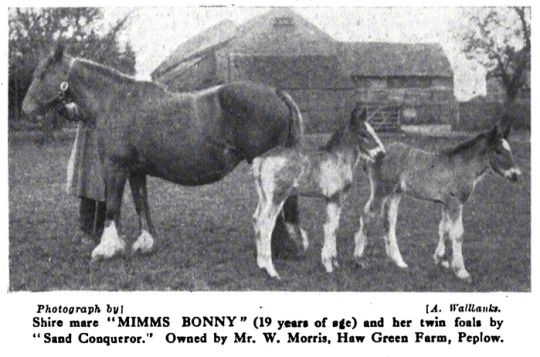
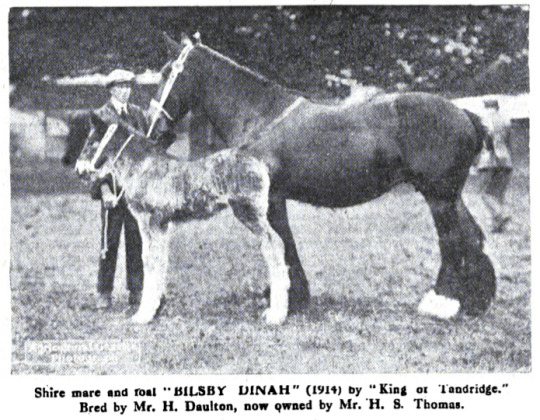
Above: Shire mare “MIMMS BONNY” (19 years of age) and her twin foals by “Sand Conqueror.” Owned by Mr. W. Morris, Haw Green Farm, Peplow. Photograph by A. Waillanks.
Below: Shire mare and foal “BILSBY DINAH” (1914) by “King of Tandring.” Bred by Mr. H. Daulton, now owned by Mr. H. S. Thomas.
The Agricultural Gazette and Modern Farming, 1920
20 notes
·
View notes
Photo
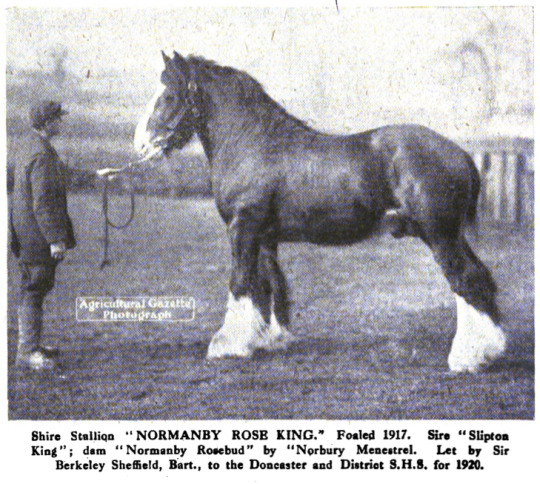
Shire Stallion “NORMANBY ROSE KING.” Foaled 1917. Sire “Slipton King”; dam “Normanby Rosebud” by “Norbury Menestrel.” Let by Sir Berkeley Sheffield, Bart., to the Doncaster and District S.H.S. for 1920.
The Agricultural Gazette and Modern Farming, 16 April 1920
#stallion#horse#heavy horse#Shire horse#Normanby Rose King#The Agricultural Gazette and Modern Farming#1920
24 notes
·
View notes
Photo
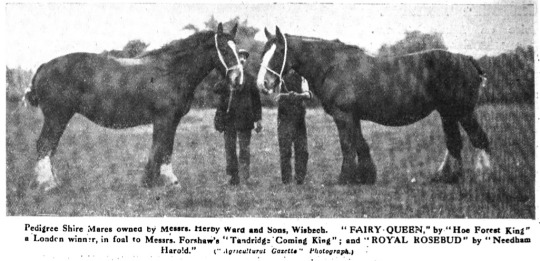
Pedigree Shire Mares owned by Messrs. Herby Ward and Sons, Wisbeck. “FAIRY QUEEN,” by “Hoe Forest King” a London winner, in foal to Messrs. Forshaw’s “Tandridge Coming King”; and “ROYAL ROSEBUD” by “Needham Harold.” ("Agricultural Gazette” Photograph.)
The Agricultural Gazette and Modern Farming, 2 April 1920
#Shire horse#mares#Fairy Queen#Royal Rosebud#draught horse#draft horse#heavy horse#The Agricultural Gazette and Modern Farming#1920
18 notes
·
View notes
Photo
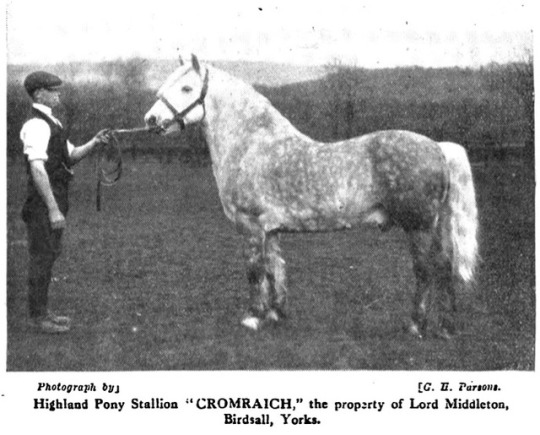
Highland Pony Stallion “CROMRAICH,” the property of Lord Middleton, Birdsall, Yorks.
Photograph by G. H. Parsons, 1920, The Agricultural Gazette and Modern Farming, Vol. 91.
#Highland Pony#pony#dapple grey#G. H. Parsons#Cromraich#history#The Agricultural Gazette and Modern Farming#1920
20 notes
·
View notes
Photo
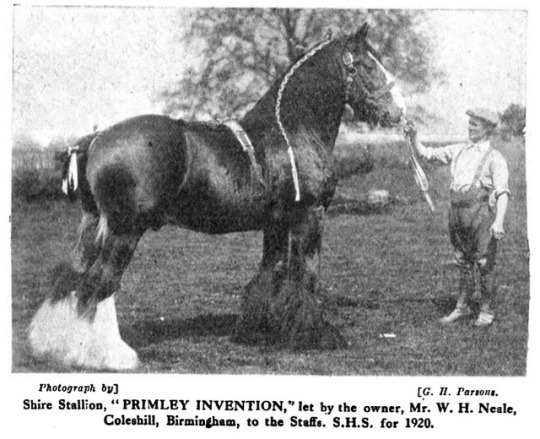
Shire Stallion, “PRIMLEY INVENTION,” let by the owner, Mr. W. H. Neale, Coleshill, Birmingham, to the Staffs. S.H.S. for 1920.
Photograph by G. H. Parsons, 1920, The Agricultural Gazette and Modern Farming, Vol. 91.
#Shire horse#draught horse#draft horse#horse#Primley Invention#G. H. Parsons#The Agricultural Gazette and Modern Farming#black and white#history#vintage#1920
16 notes
·
View notes
Photo
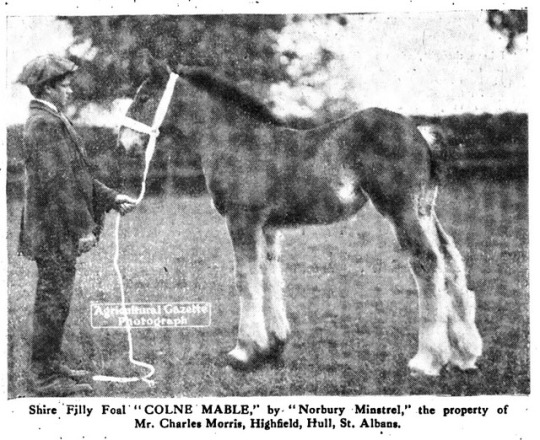
Shire Filly Foal “COLNE MABLE,” by “Norbury Minstrel,” the property of Mr. Charles Morris, Highfield, Hull, St. Albans.
From The Agricultural Gazette and Modern Farming, Vol. 91, 1920.
#Shire horse#foal#draught horse#draft horse#Colne Mable#The Agricultural Gazette and Modern Farming#vintage#history
17 notes
·
View notes
Photo
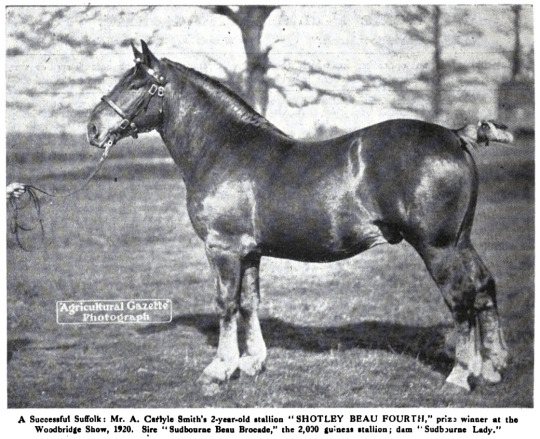
A Successful Suffolk: Mr. A. Carlyle Smith’s 2-year-old stallion “SHOTLEY BEAU FOURTH,” prize winner at the Woodbridge Show, 1920. Sire “Sudbourne Beau Brocade,” the 2,000 guineas stallion; dam “Sudbourne Lady.”
The Agricultural Gazette and Modern Farming, 11 June 1920
#Suffolk Punch#rare breed#stallion#Shotley Beau Fourth#The Agricultural Gazette and Modern Farming#1920
24 notes
·
View notes
Photo
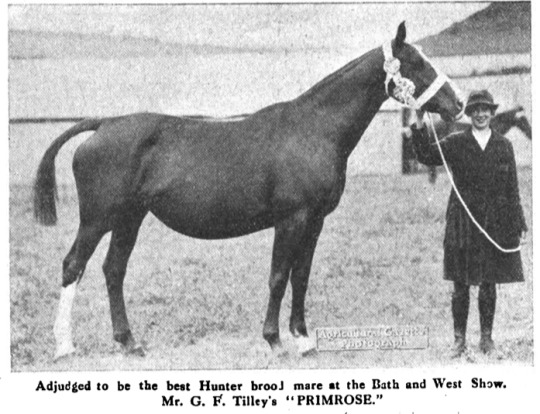
Adjudged to be the best Hunter brood mare at the Bath and West Show. Mr. G. F. Tilley’s “PRIMROSE.”
The Agricultural Gazette and Modern Farming, 11 June 1920
10 notes
·
View notes
Photo
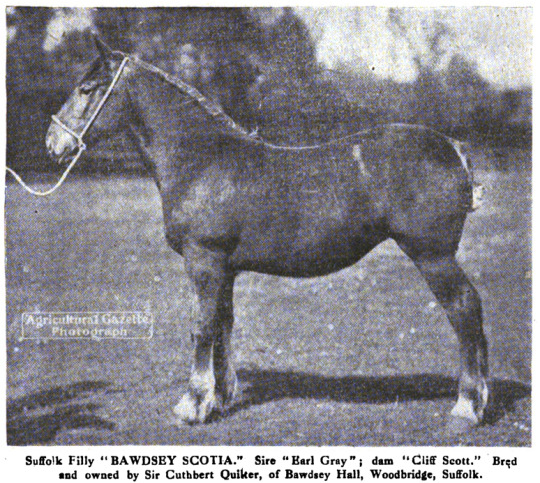
Suffolk Filly “BAWDSEY SCOTIA.” Sire “Earl Gray”; dam “Cliff Scott.” Bred and owned by Sir Cuthbert Quilter, of Bawdsey Hall, Woodbridge, Suffolk.
The Agricultural Gazette and Modern Farming, 30 April 1920.
#Suffolk Punch#rare breed#heavy horse#Bawdsey Scotia#The Agricultural Gazette and Modern Farming#1920
11 notes
·
View notes
Photo
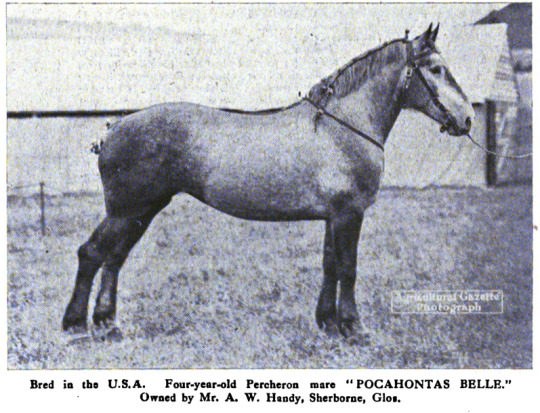
Bred in the U.S.A. Four-year-old Percheron mare “POCAHONTAS BELLE.” Owned by Mr. A. W. Handy, Sherborne, Glos.
The Agricultural Gazette and Modern Farming, 11 June 1920
12 notes
·
View notes